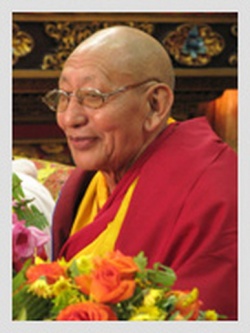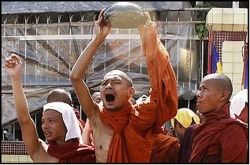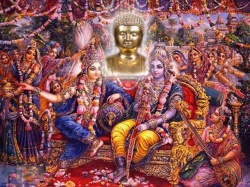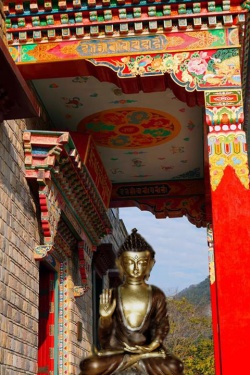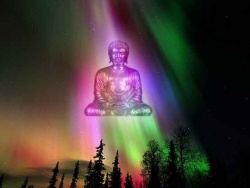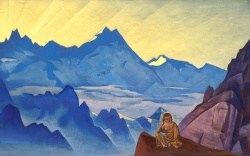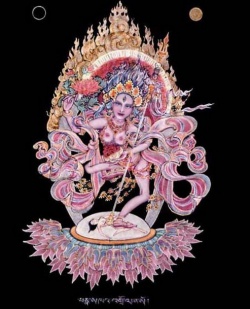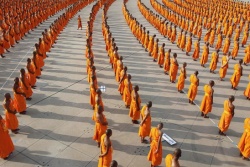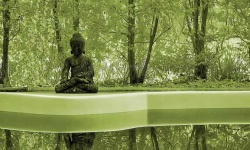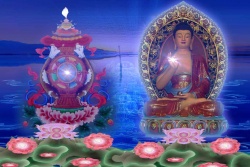Drubthob Rinpoche
Drubthob Rinpoche, popularly known as an extremely simple, humble and compassionate lama by those who know or have heard of him, was born in 1929 towards the end of the Iron Horse year, in Lhoga Dranag, a province in central Tibet, south of Lhasa.
His father Tseten Wangyal was born in Tibet in 1895, a goldsmith by profession but served for most part of his life in the Nepalese Consulate in Lhasa.
His mother Dekyi Choedon was a very simple lady from a humble Tibetan family.
Rinpoche's late parents were great devotees and patrons of Drubchen (Drubthob-Chenpo) Rinpoche, a great Yogi who is said to have spent most of his life meditating in the secluded caves of Lhoga Dranak and Lhasa.
Being patrons and devotees of the great Yogi, Rinpoche's parents made regular visits to his caves not only to receive his blessings but also to offer him rations.
This went on for twelve years.
In the year 1928, touched by the couple's great sense of devotion towards him, on one cold winter day the Yogi confessed that he had nothing to offer to them in return for their kindness and devotion over so many years, but that he would one day answer their prayers in his next life.
So saying he held out from his bare palm, a fresh peach (fruit), blessed it and asked them to accept it. Soon, Drubchen Rinpoche passed away.
Meanwhile, Dekyi Choedon conceived a child in her womb, some time after Drubchen Rinpoche passed away. When the child was just six months in her womb, she went to see Chokdra Rinpoche to seek his blessing as she had experienced some problems with her health.
As Chokdra Rinpoche saw her he instructed her thus, "Your health problem will do no serious harm to you. The child you have in your womb is a boy and his owner is the protector, "Pehar Gyalpo".
Therefore, you should take special care and attention to maintain your health and cleanliness and eat good food".
The family experienced continuous hardship for three years following the child's birth: family members fell ill, many cattle perished and obstacles in the family business increased year after year.
The parents once again went to see Chokdra Rinpoche and told him everything. Rinpoche told them they could not stay there any longer because there was great possibility of more harm from the protector "Pehar Gyalpo" to the whole of the family if they stayed.
How Ven. Rinpoche came to be known as Drubthob Rinpoche:
Upon the advice of Chokdra Rinpoche, the family finally moved to Lhasa. Soon after they arrived in Lhasa, Dekyi Choedon fell sick.
They went to Kangyur Rinpoche for advice and he, too said the family had been affected by the protector, "Pehar Gyalpo" and added that the protection puja should be performed.
When the boy was about 7 years old his parents invited Ven. Kangyur Rinpoche to their home to perform offerings to "Pehar Gyalpo". During the prayers the boy innocently reached out and touched the prayer drum & bell of Kangyur Rinpoche.
At this incidence Rinpoche's mother was about to discipline the boy when Kangyur Rinpoche told her not to do so.
Moreover, Kangyur Rinpoche recognized the boy, explaining that he was none other than the reincarnation of the great holy yogi Drubchen Rinpoche whom they had served for 12 years.
And Kangyur Rinpoche told the parents that the boy should be called “Drubthob Rinpoche", which to this day is the name by which Rinpoche is known.
Kangyur Rinpoche further advised the family that the boy should be ordained as monk in the Drepung Loseling monastery; at the time, the world's largest monastic university.
Ven. Rinpoche's studies in the profound doctrine of Buddhism:
By the age of nineteen, Rinpoche had mastered the art of Buddhist chants and rituals. It was then that he was pronounced one of the sixty "Donsangs" (perfect chanters) out of the seven thousand monks at Drepung Monastery.
Among the sixty he was proclaimed to be the outstanding one.
For the next six years till the age of twenty-five, he devoted himself to the study of the subjects of logic, Buddhist Philosophy and it's texts:
Prajnaparamita (She-rab ki Pharchin) and Madhyamika (oo-ma), under the directions Gen Pema Gyaltsen and Pom-para Yeshi Dhondup.
He also studied the Vinaya (dhul-wa Gyatso) under the direction of Gen Lobsang Tsewang.
At the age of twenty-five he received the title of "Drha-sang Chentse". Soon after which Rinpoche studied the practice of Phowa under the direction and empowerment of Kangyur Rinpoche.
From the age of twenty-five to twenty-eight he concentrated on retreat and various forms of meditation under Lhaptsun Rinpoche and Kangyur Rinpoche.
His fame in these practices and effects of his profound selfless vision spread quickly among the people and as a result many came with faith and devotion, seeking his blessings.
Chinese invasion of Tibet and Rinpoche's imprisonment:
When the communist Chinese brutally invaded and occupied Tibet, the saddest moment in Tibetan history befell the Tibetans.
A nation that had not seen war for centuries had to face the military might and sophisticated weapons of communist China.
Nevertheless, every soul in the nation along with the ill-equipped and unorganized Tibetan Army, fought back bravely to resist the brutal Chinese occupation, with patriotism as their only common weapon.
Almost every Tibetan faced what he or she had to in order to defend the country and it’s rich cultural heritage. Ven. Rinpoche was one among those who suffered the consequences of the invasion.
Rinpoche had started distributing "Tsonsung" (Protection Amulets) freely amongst the Tibetan Army and to all who asked for them, to protect them against Chinese weapons and bullets. Many people survived from the Chinese weapons and bullets as a result of his "Tsonsung."
The Chinese later on came to know about this and sentenced Rinpoche to three years imprisonment on the charge of distributing Tsonsungto the Tibetan Army. Rinpoche remained in prison three years (early 1958 to late 1961.)
Escape from prison and Rinpoche's selfless activities in Nepal
During these years his father, Tseten Wangyal made several attempts to convince the Chinese that Rinpoche was Nepalese by origin.
Finally in 1961, after a long negotiation between the Nepalese Consulate and the Chinese bureaucrats, his hard work brought reward when the Chinese finally decided to escort Rinpoche to Shar-Singma, close to the South Eastern boarder of Tibet, to release him.
It was here that he entered Gangtok (Sikkim) and reached Kalimpong (District Darjeeling, India) and finally in 1962 made it to Kathmandu, Nepal.
At the Nepalese boarder, he was received by his patrons Go-Knonpo (blue door), who had invited him because the people of Kathmandu felt the need for a resident Lama.
Upon arrival in Kathmandu, Rinpoche felt great dedication and commitment to stay there and serve the spiritual needs of the local people from all walks of life. Almost every individual that knows him speaks of his selfless deeds and simplicity.
Drubthob Rinpoche, being a simple Gelong monk, has always been available for everyone who seek his help and blessings.
Rinpoche's special attention has been to treat people with ailments like epilepsy and various nervous disorders, besides giving general health advice and pulse checks, for which Rinpoche has been sought out for since his early medical education in Tibet.
Drubthob Rinpoche is always known for his selfless caring for all those facing ill health and/or death.
Rinpoche's disciples from all walks of life invite him to their homes to perform Buddhist rituals prayers i.e., for house blessings, health reasons, weddings, births and deaths.
For those whom have passed away Rinpoche performs the "Phowa" ritual, which helps the souls to be reborn in a better world.
Drubthob Rinpoche is especially well known for doing "Mo"(Divination) for his disciples to provide guidance for whatever ventures and activities they may be pursuing.
Mo is normally a Buddhist practice of unraveling the unknown outcome of any given situation.
Drubthob Rinpoche is also well known for performing ritual to dispel obstacles from people’s lives, and exorcisms of negativity, etc. Drubthob Rinpoche's vision is always to help everyone irrespective of his or her faith and creed.
Though originally a Nepalese but born in Tibet, for decades Rinpoche has been a kind father for the hundreds of Tibetan refugees coming to Nepal and has been a main source of encouragement for them. For years Rinpoche has visited each of the many Tibetan refugee centers in Nepal to perform prayers for their well-being.
